The unacknowledged root causes of unsustainability


· 12 min read
In a previous article, we have highlighted how human behavior patterns are at the core of the meta-crisis of sustainability. This time, we are going to explore where these unsustainable patterns come from and how they can be changed:
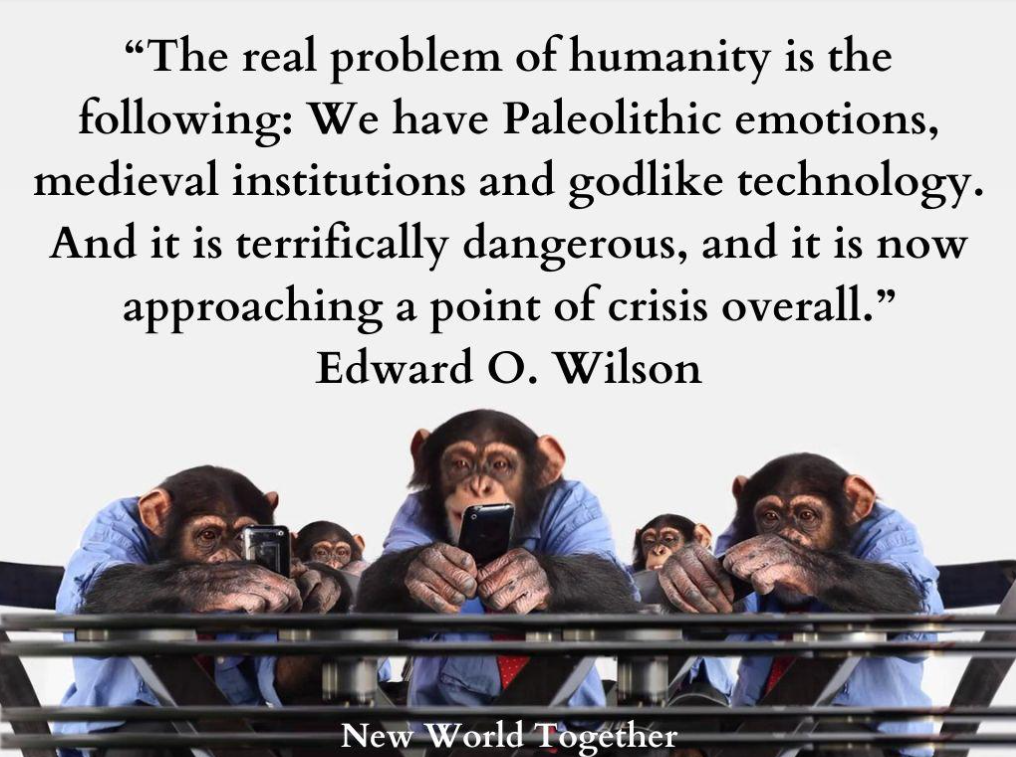
Collectively changing behavior appears to be the only realistic pathway to integrate our planetary limits and avoid the collapse of our global civilisation. To do so, it seems that we will have to explore part of ourselves that we do not know of yet. In fact, an estimated 95% of our choices and actions are the result of unconscious mechanisms and unless we are collectively making a conscious choice to cocreate a global disaster by pushing unsustainability to the limits, our unsustainable behavior patterns stem from unconscious mechanisms which we are not aware of yet.
To better understand the nature of these unconscious patterns, we can use the ABC technique which stands for Antecedent, Behavior, Consequences. Through it, we learn that every behavior pattern is the result of past events and has consequences. According to this model, to change a pattern, it is, therefore, important to acknowledge its antecedent as well as its undesirable consequences. If we use this model to look at the big picture, humanity’s past history had generated certain behavior patterns that are unsustainable and that will lead to the collapse of our civilisation if they are not addressed. In other words, if we want to understand the nature of the patterns that are bringing us to the verge of disaster, we need to understand our past.

If we take a big step back to look at our species' past, we see that sapiens is a newcomer on Earth. As a by-product of life evolution of animal ancestry, he has spent most of his existence as part of nature as a hunter-gatherer. The sedentarisation of humans is extremely recent in evolution, let alone the access to modern technology that has allowed humans to dominate other species. It means that for most of its existence, sapiens had to survive in the wild which as we know can be quite dangerous, especially for humans that are not particularly powerful physically.

To survive, sapiens had to face 3 major types of existential threats, which shaped our primal survival instinct.
Hostility: all humans had to face the threat of predators, rivals and illnesses
Scarcity: all humans are at risk of not having access to the vital resources that they need
Separation: all humans faced the threat of being marginalized and rejected by their tribe (aside from the risk of being persecuted by the group, humans are social animals that thrive in groups and are extremely vulnerable when they are isolated)
To compensate for a lack of body strength, speed and agility compared to other mammals, sapiens developed their intelligence which could be notably used to create increasingly sophisticated languages, tools, weapons and narratives around which to build societies. This intelligence was used in priority in order to respond to these threats. In the process, those who learned to fear the threats of hostility, scarcity and separation developed a primal survival instinct specifically designed to neutralize them.
Logically, this led to ruthless rivalry as human tribes inevitably came to have conflicts for territories and their resources. The tribes that were best at conquering, dominating and controlling territories, hoarding resources and getting large groups to conform to their social norms greatly increased their chances of survival, developed and conquered the surface of the globe. These tribes had cultures that valued and nurtured power, wealth and social status. They became more and more dominant all over the globe.

Tribes that had adopted a more equalitarian or symbiotic culture or that paid less effort and attention to developing their skills in dominating, hoarding and social engendering were less competitive and more likely to be subjugated, colonized or wiped out. Engaging and performing in rivalry for power, wealth and status has become a norm and a need to survive for almost all tribes on the surface of the planet.
Those who did best at this primal survival game were coming from Western Europe, the region which saw the rise and fall of the roman empire and in much more recent history the ignition of the two-World War. Between 1492 and 1914 Europeans spearheaded the industrial revolution, conquered and colonised 84% of the surface of the globe, using their industrial power and wealth to dominate, control and exploit other continents.
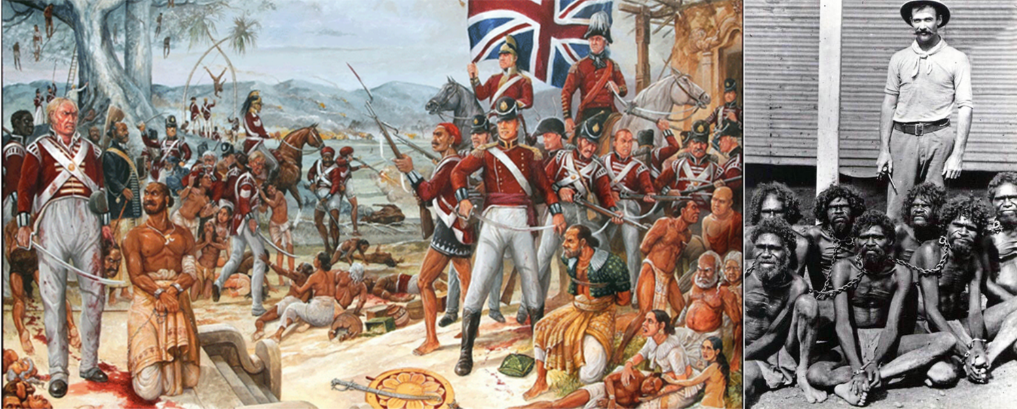
It is this industrial revolution that marked humanity’s entrance into the Anthropocene. A new era characterized by unprecedented technological progress and the undisputed domination of the Earth by the human species. The Anthropocene is a game changer which sees humanity extracting itself from a natural environment which can now be dominated, exploited and transformed to respond to the thirst for more power, wealth, and status.
The Anthropocene will be followed by the great acceleration in the mid of 20th century and is characterized by the globalisation of our civilisation and a dramatic and exponential surge in human population, technological progress and impact. It is just 20 years after the beginning of the great acceleration that the first planetary overshoot was recorded: from that moment, humanity’s ecological impact will be greater than what the Earth's ecosystems can sustain.
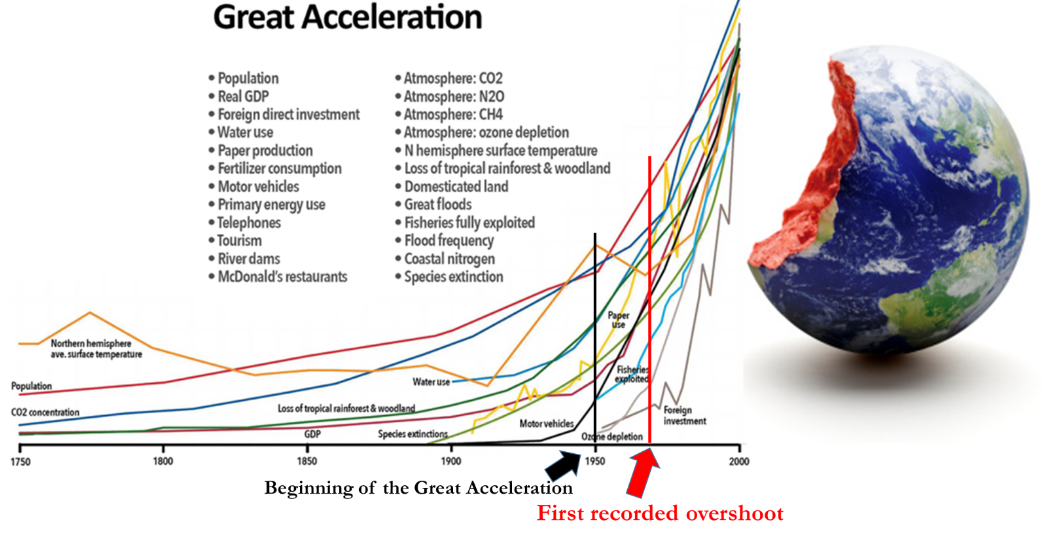
We as a species have failed to acknowledge the paradigm shift that the Anthropocene is as well as its implications. In this new paradigm in which humans are now the stewards of the earth, the dominant primal survival patterns that have allowed humans to conquer and dominate the surface of the globe are becoming increasingly self-destructive and dangerous. This is happening for a simple reason: the current exponential technological progress that we generate amplifies the harmful consequences of our primal survival patterns.
The impulse to dominate and control the environment creates ruthless rivalry for power that generates conflicts that are more and more dangerous in the presence of increasingly powerful weapons of mass destruction.
The impulse to accumulate leads to competition in order to hoard resources which results in growing inequalities and depletion of natural resources in the presence of decoupled means of extraction on an industrial scale.
The impulse to conform to the dominant norms in order to be validated and access social status leads to a marginalisation of difference and a perpetuation of the status quo reinforced by powerful technologies which can be used for mass surveillance and social engineering on a massive scale. The status quo is posing an existential threat when change is a vital need.
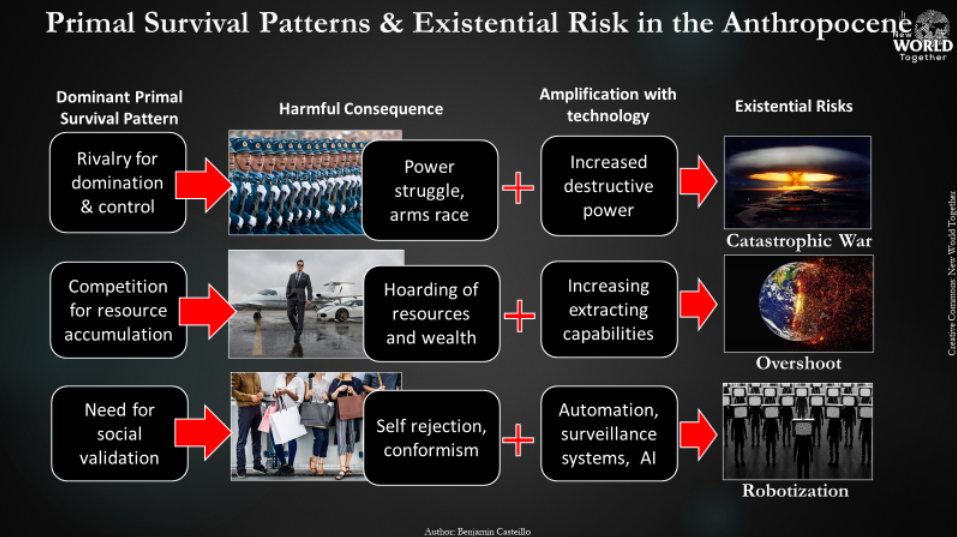
It is quite easy to understand why these increasingly unsustainable primal survival patterns have remained unnoticed until now, they have been rationalized, normalized and perpetuated through the social structures that dominate our globalised civilisation.
The drive to dominate and control the environment led to the creation of nations, which are social constructs with borders and armed forces specifically designed to dominate and control entire territories and their populations.
The thirst to accumulate resources led to a productivist and consumerist society, which has been designed to place all economic actors in competition with one another for short-term profits, unlimited accumulation of capital and compulsive growth.
The thirst to seek external validation led to all the dominant social norms, which define what is encouraged, valued, incentivized and prioritized in society and what is discouraged, unrecognized or penalized.
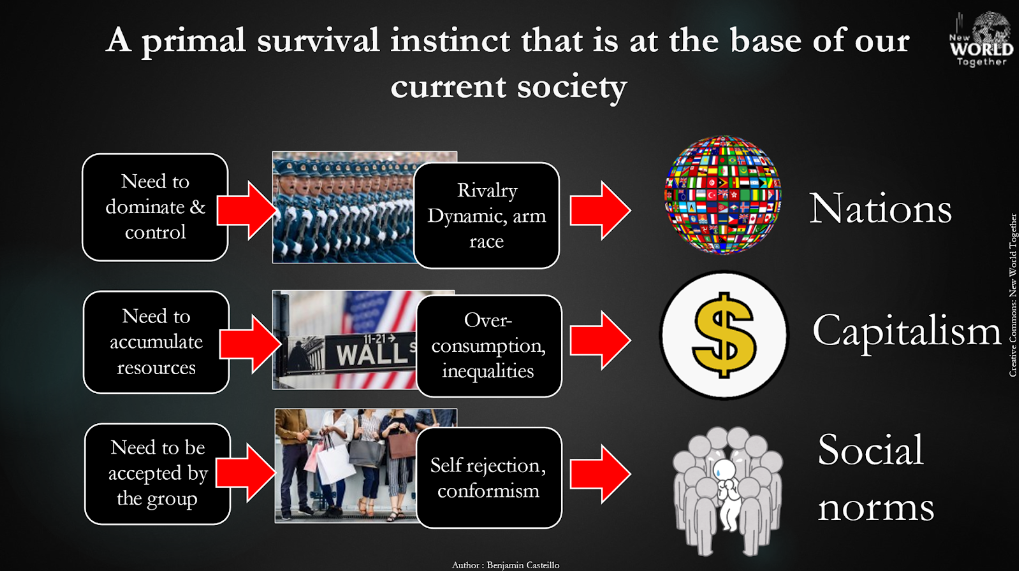
This dominant primal survival instinct also self-perpetuates below our collective level of awareness, creating vicious cycles which if they are not stopped, can only lead to extremely undesirable futures.
The primal impulse to dominate and control the environment irremediably leads to rivalry for power and violent conflicts which perpetuates the danger and therefore fear of hostility. If unchecked, this can only result in catastrophic wars.
The primal impulse to compete in order to hoard resources leads to their depletion while at the same time increasing inequalities, which perpetuates the danger and fear of scarcity. Hence the overshoot of our planetary limits will inevitably lead to a systemic collapse if it is not stopped (our economy and lives depend on natural resources, so depleting them is basically destroying our future).
Conforming to the dominant norms leads to the marginalisation of difference which perpetuates the danger and fear of separation. And if this is not tangible to you, think how many times you have been afraid to express your opinion for fear of being rejected?
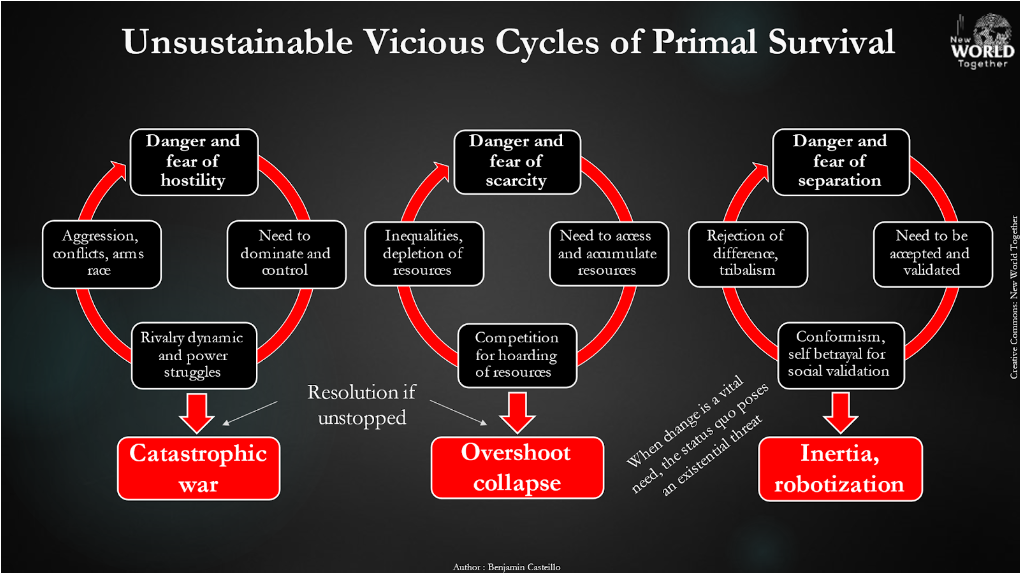
These 3 vicious cycles perpetuating the dominant primal survival instinct are not separated from one another but interrelated. For example, a group that fears hostility from other groups will fear not having enough resources to defend itself and will also fear any opinion that challenges the norms of the group. This means that we can’t stop one of these vicious cycles without stopping the 3 others. In other words, to achieve a sustainable transition, we need to live in peace with one another and for that we need to learn to share our planetary resources and to accept one another as we are. It’s not rocket science but it’s a big game changer, especially when it goes against inherited primal survival instinct.
So, with this new understanding, it should be clear that the meta-crisis of sustainability threatening the future of humanity is not just an ecological or socio-economic problem, but a human problem deeply rooted within us. It is happening for a very simple reason: the dominant primal survival instinct developed over hundreds of thousands of years of threats before the Anthropocene has now become self-destructive within the Anthropocene. Because it has been conveniently mistaken for “unchangeable human nature”, it has self-perpetuated below our collective level of awareness (within the collective unconscious) and is now becoming increasingly dangerous in the context of exponential technological progress.
“The real problem of humanity is the following: We have Paleolithic emotions, medieval institutions and godlike technology. And it is terrifically dangerous, and it is now approaching a point of crisis overall.”
Edward O. Wilson
The new science of trauma can allow us to better understand what is at the core of this primal survival instinct. In fact, it is impossible to deny the traumatic nature of the past history of humanity which is marked by centuries and centuries of invasions, wars, genocides, severe deprivation, famines, oppression, persecution, slavery. These have resulted in layers and layers of collective and intergenerational traumas: deep wounds that have been ignored and yet have played a great role in shaping our identities, social structures and cultures.
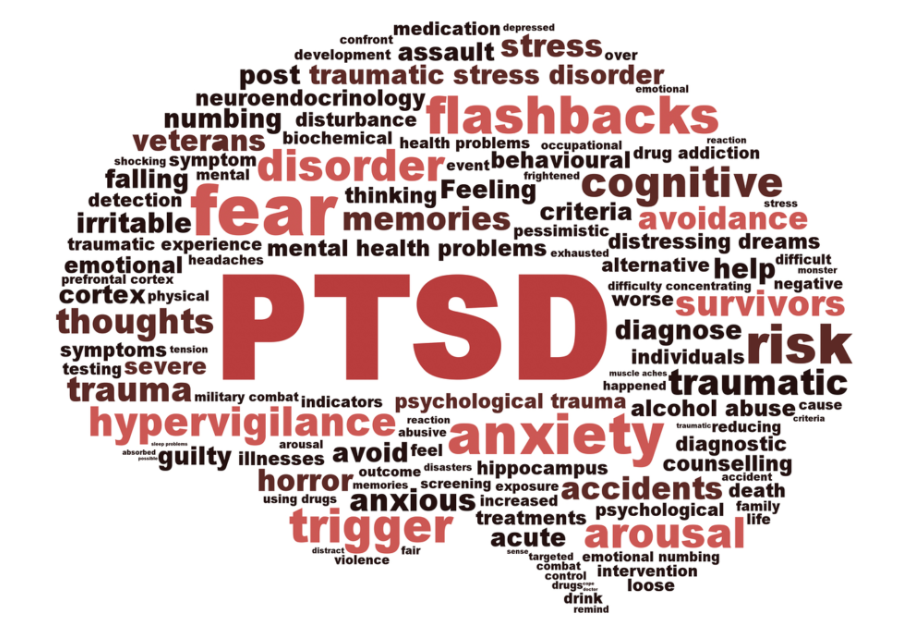
Contemporary science is pretty clear on the consequences of unresolved trauma. They result in a disconnection from the self and what could be described as a fragmented ego identity. They perpetuate a state of discomfort and existential anxiety associated with compulsive behaviors. To deal with this inner discomfort and numb the fear and pain, people develop all kind of strategies, including addictions to drugs, alcohol, but also consumerism, power, money, status, sex, work and… beliefs.
In fact, a key aspect to understand is our difficulty to face reality as it is coming from the interrelation between unresolved traumas from a bygone past and false beliefs. The human mind seeks to rationalize everything including the patterns resulting from the fear and pain repressed in the collective unconscious. For example, as the result of the unresolved collective and intergenerational trauma of scarcity left by thousands of years of severe deprivation, many people still fear not having enough. This fear is being suppressed and rationalized with the belief that extracting, producing and possessing always more is a vital need.

As such our global economy’s addiction to GDP (Gross Domestic Product: the monetary value of all finished goods and services generated by a territory during a specific period) growth is deeply rooted in the unresolved trauma of scarcity. If such fear and belief were functional in the past to deal with scarcity, it is completely unfit to deal with the new situation of resource overconsumption and planetary overshoot. Instead of resolving the trauma of scarcity, it creates vicious cycles of hostility and separation, which shows that the vicious cycle of danger and primal survival instinct are also traumatic by nature.
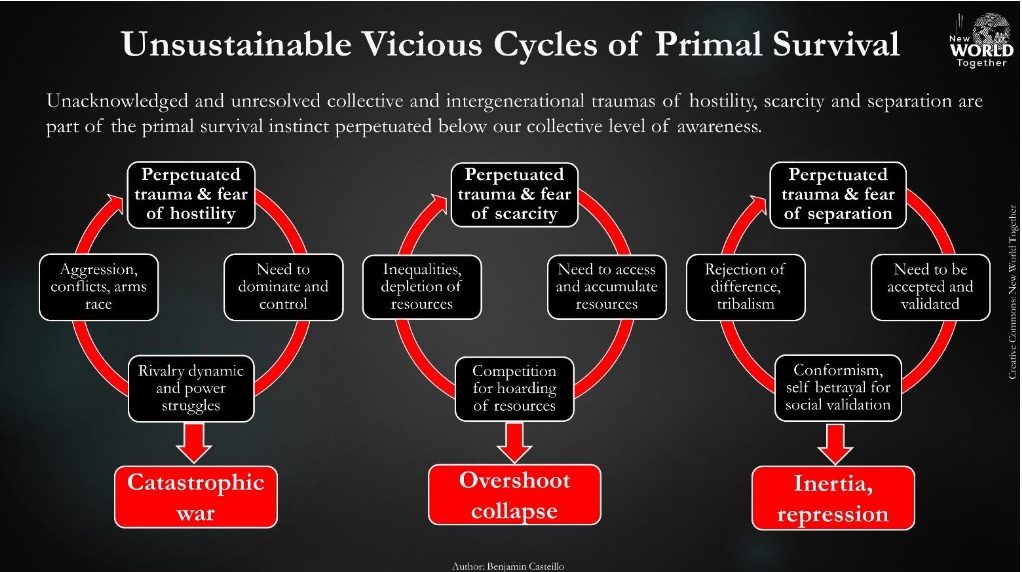
Understanding that, we start to have a clear picture of the problem, its fundamental and hidden root causes. Humanity is in a state of collective and intergenerational traumatic stress disorder, rationalised with false beliefs and mistaken for unchangeable human nature. This unconscious and fear driven ego state perpetuates a primal survival instinct that is increasingly self destructive and unsustainable in the context of exponential technological progress.

Recognizing our grim past, and our unresolved wounds is extremely sensitive as it results in a lot of emotional discomfort such as shame, guilt and grief. This is particularly challenging to do in a society valuing competitiveness, performance and appearances over vulnerability, authenticity and empathy. This explains to a large extent why we are still in this ubiquitous state of denial, escapism and apathy hindering our ability to face and understand the great challenges of our times. Because of the mental and emotional discomfort, they trigger both the problem and its fundamental causes hence they have been repressed and kept unconscious.
The meta-crisis of sustainability is the elephant in the room which obliges us to face ourselves and our unresolved issues. Yet, if through our past history we have learned to identify and fight enemies outside of ourselves, we lack knowledge and experience when it comes to dealing with the “enemies” inside of ourselves. To achieve a global sustainable transition, we will have to find the courage to acknowledge the false beliefs, irrational fears and unhealed wounds that have kept us in this primal state of survival until now so that they can be respectively dissolved, released and healed. As Carl Gustav Jung noted: “Until you make the unconscious, conscious it will direct your life and you will call it fate”.
The global and systemic crisis of sustainability we are facing is nothing less than a call for a collective awakening and expansion of consciousness: an invitation to recognize the interrelation between our inner and outer words. To do so, a proper campaign of awareness about the problem, its hidden root causes and solutions is needed. It would result in a cultural renaissance based on self knowledge, a psychological reorganization and a conscious evolution that would trigger profound changes at all levels, which is exactly what is needed to successfully and safely achieve a global sustainable transition.
How we can achieve this, will be developed in a future article…
illuminem Voices is a democratic space presenting the thoughts and opinions of leading Energy & Sustainability writers, their opinions do not necessarily represent those of illuminem.
illuminem briefings

Labor Rights · Climate Change
illuminem briefings

Architecture · Carbon Capture & Storage
Barnabé Colin

Biodiversity · Nature
Euronews

Degrowth · Public Governance
Politico

Public Governance · Climate Change
Mongabay

Climate Change · Environmental Rights